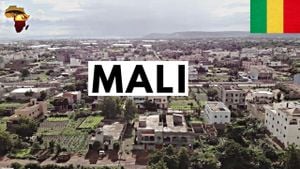Tragedy struck the popular backpacker haven of Vang Vieng, Laos, as six tourists—hailing from the United States, Australia, the United Kingdom, and Denmark—lost their lives due to suspected methanol poisoning. This horrifying incident, which has raised significant alarm about the safety of alcoholic beverages in the region, unfolded following a night of drinking at the Nana Backpacker Hostel.
The unfortunate string of deaths began on November 12, when several tourists fell unwell shortly after consuming what they believed was vodka. Among the victims were 19-year-old Australian students Bianca Jones and Holly Bowles. The two friends had enjoyed what they thought was just another enjoyable evening out but were instead met with dire consequences. While Jones passed away on November 21, Bowles followed just days later, with authorities confirming their causes of death linked to dangerous levels of methanol found within their systems.
Simone White, 28, a British lawyer, also tragically succumbed to the same fate shortly after the young Australians. Her family described her as vibrant and full of life, emphasizing how deeply loved she was both personally and professionally. The sudden loss of such promising individuals has sent shockwaves through their communities back home.
This poisonous substance, methanol, commonly used industrially as antifreeze, is sometimes illicitly added to alcoholic drinks. Disturbingly, as low as 30 milliliters can be lethal—a reality underscored by troubling reports from Laos where local establishments sometimes cut alcohol quality to save costs. This practice, alarmingly prevalent, has put careless revelers at considerable risk, leading health officials to issue urgent warnings. Australian's Foreign Minister, Penny Wong, noted, "Drink spiking and methanol poisoning are far too common in many parts of the world."
Authorities quickly responded to the crisis with the arrest of Duong Duc Toan, the hostel's manager. While he expressed his intent to cooperate fully with investigators, claiming he had no knowledge of any wrongdoing, the tragic consequences left many questioning the safety standards maintained by hospitality businesses catering to tourists, tragically pointing to systemic oversight. Since the incident, countries like the United States and Australia have issued travel warnings, urging their citizens to evaluate the risks with alcohol consumption when visiting Laos.
The Lao government's reaction has included promises of thorough investigations, coupled with expressions of heartfelt sorrow for the families affected. They have pledged to work closely with embassies and consulates to navigate this distressing situation and prevent future tragedies. Yet, many backpackers continue to flock to the region, treating it as merely another stop on their Southeast Asian adventure itineraries. Despite the chaos, local businesses remain eager for the peak tourist season as they anticipate the usual influx of visitors seeking thrilling nightlife experiences.
Vang Vieng's evolution from notorious party zone to purported eco-tourism hotspot has not completely abated the darker side of its allure. A legacy of reckless behavior and high-risk activities among oft-inebriated young travelers leaves open the question of how long before the balance between pleasure and prudence—or perhaps accountability—is restored.
Health authorities are now patrolling bars and issuing alerts to monitor the drinks being served. This remains especially true following reports and cases often linked back to establishments where tourists enjoy local culture but at potentially dire risk. Backpackers have become increasingly aware of the dangers surrounding cheap alcohol options yet are often wary of what constitutes safe choices.
Local medical professionals have expressed concern, stating instances of methanol poisoning may not be as rare as previously believed. Reports suggest there could be unreported cases lurking beneath the surface of joyful nights cloaked by darkness—when the temptation of partying outstrips caution.
Tourist safety, particularly concerning alcohol consumption, must evolve with the vibrant lifestyle sought by so many adventurers. Vang Vieng, known for picturesque views and stunning natural landscapes, unfortunately, now holds the unwanted spotlight associated with tragedy.
Authorities face the challenge of ensuring tourist safety without entirely disrupting the vibrant culture backpackers cherish. The intersection of nightlife entertainment, responsible tourism, and stringent health measures must shift from mere discussions to actionable reforms if this beloved destination is to reclaim its reputation positively.
For the grieving families, the bittersweet reality of these unanticipated losses restructures their narratives, forever altering their memories of adventure-filled getaways turned tragic. The hope remains for clearer guidelines and enforcement within Laos’ tourism sector, aiming to protect future travelers from the ensnaring dangers lurking behind those seemingly carefree nights of fun and excitement.
This event marks not just the end of lives but also potentially sets the stage for heightened vigilance from tourists and the local government alike. Without definitive measures and strict regulations, Vang Vieng risks becoming synonymous not only with the thrill of backpacking but also with heart-wrenching loss.



